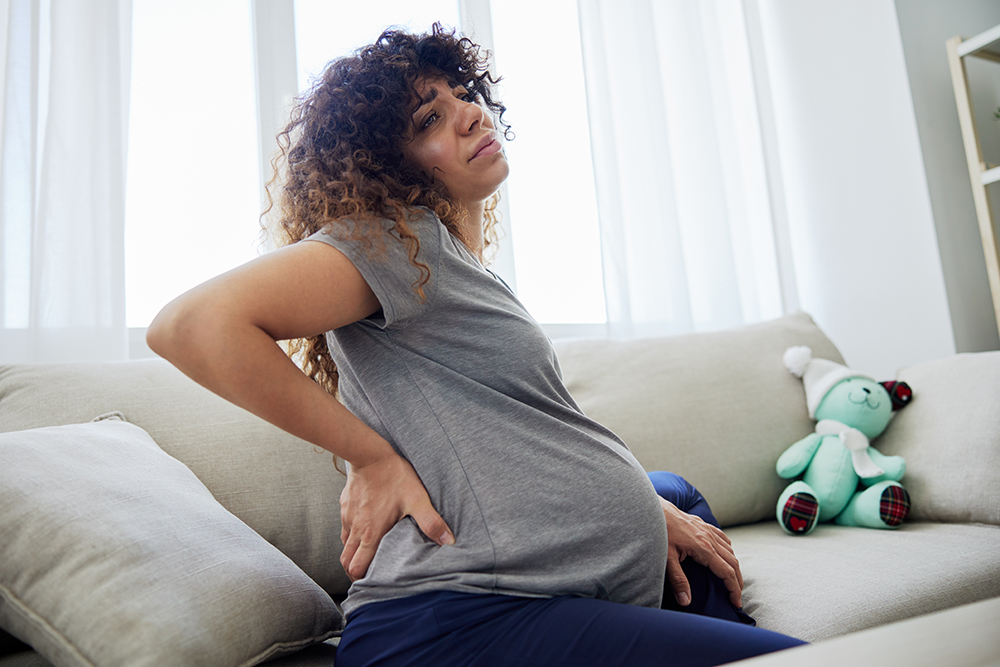During pregnancy, there are a lot of changes that happen in your body. All of these changes are to help accommodate your growing baby. A change in your hormones can affect your sacroiliac (SI) joint. This joint connects your sacrum, the triangular bone at the base of your spine, to the iliac bones, the large pelvic bones. This joint helps move the forces of your upper body and lower extremities to help keep you stable during various movements. It can be common to experience pain in your SI joint during pregnancy. It affects up to half of women at some point during their pregnancy. With so many women affected by this condition, it’s important to know what’s going on and how to deal with it effectively so this pain doesn’t put a damper on your quality of life.
Symptoms of SI joint pain during pregnancy
So many things are happening in your body during pregnancy, and it can be hard to keep up with what pain is from what issue. SI joint pain can cause a variety of symptoms, including:
- Lower back pain — Do you have a nagging pain in your lower back that may radiate through your buttocks and down into your thighs? This lower back pain can be a hallmark symptom of SI joint dysfunction during pregnancy.
- Buttock pain or tenderness — You may feel like you have a tender or sore spot on one side of your buttocks.
- Hip pain — You may find your hips stiff or painful when you do certain movements. It can happen when you go from lying down or sitting to a standing position.
- Shooting pain — You may experience a shooting pain down the back of your thigh or into your groin area.
- Difficulty walking — Later in pregnancy, you may already have adopted the “waddle walk,” but SI joint dysfunction can make walking, climbing stairs or standing even more challenging.
- Challenging movements — SI joint pain can strike harder during certain movements like bending, twisting or lifting. Lifting can be a particular trigger, especially if you are lifting other children.
Triggers of SI joint pain during pregnancy
SI joint pain can be common during pregnancy, but what exactly triggers this condition? Issues causing your pain can include:
- Baby weight — The weight you gain during pregnancy from the expanding uterus, growing baby and fluids of pregnancy can all add extra stress on your SI joint.
- Hormones — Pregnancy sends your hormones into overdrive. A necessary hormone called relaxin increases through pregnancy. It’s essential to help get your body ready for delivery, but relaxed ligaments can also become painful.
- Posture — A baby bump throws your center of gravity off and can make your posture go wonky trying to find a comfortable position. Slipping into bad posture might give you some temporary relief, but it can wreak havoc on your SI joint and cause you more discomfort.
- Prolonged periods of standing or sitting — Pregnancy causes things to shift to new places in your body. If you don’t make sure to take breaks when you’re going to be sitting or standing for long periods, it can cause SI joint pain. Muscle imbalances and added pressure can aggravate your SI joint.
How can you find pregnancy SI joint pain relief?
Pregnancy causes all kinds of changes in your body and can also limit what you can do to find relief. Safe treatments for SI joint pain during pregnancy can include:
- Physical therapy — There are many techniques your physical therapist can use to help your SI joint pain. They can design a personalized treatment plan that can help you strengthen muscles, improve flexibility and fix your posture.
- Pregnancy support belts — These supportive belts can help take some of the baby weight off your SI joint. A belt can give you a much-needed break and some relief from the discomfort.
- Birthing ball — A birthing ball, also known as an exercise or stability ball, can help relieve your pregnancy SI joint pain. Sitting on this ball and gently rocking back and forth or side to side can help provide gentle movement and support for your pelvis. This can help reduce pressure on your SI joint and provide you with pain relief.
- Heat and cold therapy — Heat and cold therapy can help alleviate pain and inflammation that can be associated with SI joint pain. Applying a heating pad to the affected can help increase blood flow to the area. This boosted circulation can help promote relaxation and reduce muscle tension. Applying a cold pack can help numb the area. This can help provide you with temporary pain relief and reduce swelling. You can alternate between the two to find the sweet spot of relief.
- Medication — Pregnancy can make it difficult to find medication that is safe to take. Make sure you discuss any medications, even over-the-counter pain relievers, with your health care provider before taking them. They can help direct you to pregnancy-safe pain relievers or topical creams that can help manage your SI joint pain.
Physical therapy modalities for SI pain during therapy
Physical therapy can be a safe and effective treatment to help alleviate SI joint pain. Modalities that are safe include:
- Manual therapy — Manual therapy is one of the go-to techniques physical therapists use for many conditions, including SI joint pain. Manual therapy techniques like soft tissue mobilization are used to help manipulate muscles, tendons and ligaments that surround the SI joint. Your physical therapist will apply gentle pressure and use stretching techniques to help alleviate tension, improve mobility and reduce inflammation to promote healing in your SI joint.
- Dry needling — Dry needling is a technique used by certified physical therapists to stimulate a healing response and release muscular knots. Your physical therapist will insert thin, sterile needles into trigger points and tight muscles around the SI joint. As these trigger points release, it can help alleviate pain and improve your range of motion. Discuss this technique carefully with your health care provider and physical therapist, as there can be disagreement about using dry needling during pregnancy.
- Therapeutic massage — Therapeutic massage can help reduce tension and promote relaxation in the muscles surrounding the SI joint. Therapeutic massage can help boost circulation, reduce inflammation and improve your overall comfort in your pregnancy. Your physical therapist will be sure to only use techniques that are safe for pregnancy.
- Therapeutic exercises — Your physical therapist can create a customized exercise program intended to help strengthen the muscles that support your SI joint. These exercises will target your core, pelvic floor, hip and buttock muscles. These exercises can improve your stability and promote pain relief. Specific exercises that may be recommended can include pelvic tilts, cat-cow stretches, side-lying leg lifts and hip flexor stretches.
- Pelvic floor rehabilitation — Pelvic floor exercises, like Kegels, can play a vital role in helping to manage SI joint pain during your pregnancy. These exercises help strengthen your pelvic floor muscles to provide better support and stability for your SI joint. A physical therapist can help ensure that you are doing these exercises correctly to achieve optimal outcomes of reduced symptoms and improved functional capacity.
It’s important to do the initial exercises under the guidance of a physical therapist to ensure your safety and the effectiveness of the exercise. Your physical therapist may create a routine for you to also complete in between office visits. If any exercises cause you discomfort or make your symptoms worse, stop them immediately and consult with your physical therapist or other health care provider.
Will SI joint pain go away after delivery?
Many with SI joint pain experience relief after delivery. However, the timeline for recovery can vary. It takes time for your body to adjust back post-delivery, and how long the SI pain sticks around can be influenced by how severe the pain was during pregnancy. To help the pain and your recovery, it’s important to take care of yourself. Listen to your body, rest when you need to rest and don’t be afraid to ask for help if you need it.
If your pain continues or worsens after delivery, it’s crucial to consult with a health care provider for further evaluation. You may need to continue physical therapy or explore other options depending on what is causing your SI joint pain to linger.
SSOR can help you manage your SI joint pain and enjoy a more comfortable journey to motherhood
At SSOR, we understand that the discomfort pregnancy SI joint pain can bring can require a multifaceted approach to address symptoms and find relief. Our expert team of physical therapists offers invaluable support through our tailored treatments that are designed with pregnancy safety and comfort in mind. We strive to provide compassionate and personalized expertise and guidance to help expecting mothers navigate SI joint pain. Together, we can prioritize your well-being as you go through the transformative journey of pregnancy to motherhood.
Call us or request an appointment today to start your healing journey from pregnancy SI joint pain.

